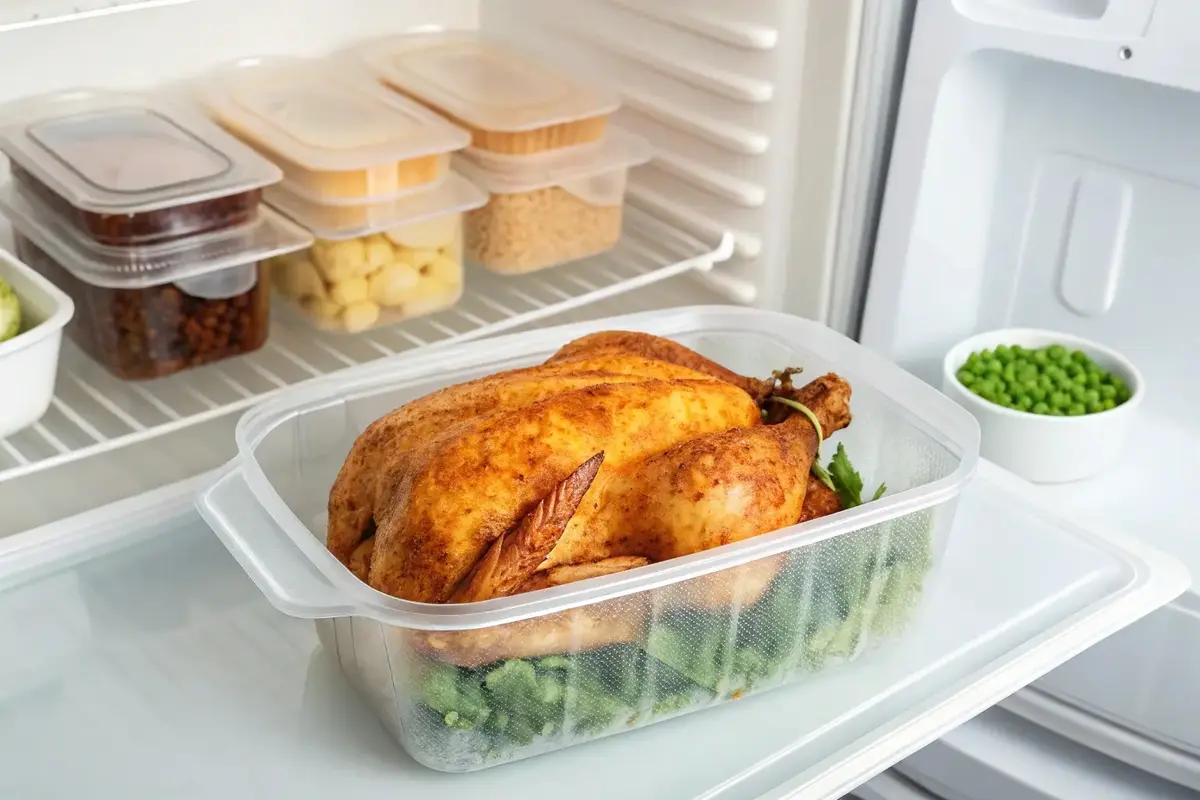Introduction
Leftover rotisserie chicken is a lifesaver for quick and delicious meals, but knowing how long it’s safe to keep in the fridge is crucial. Proper storage, reheating techniques, and understanding spoilage signs can make all the difference in ensuring your meals remain flavorful and safe. This guide will break down how long leftover rotisserie chicken is good in the fridge, while also offering tips to maximize its freshness.
The Shelf Life of Leftover Rotisserie Chicken
How Long Does Rotisserie Chicken Last in the Fridge?
When stored correctly, leftover rotisserie chicken remains safe to eat for 3 to 4 days. This timeframe follows the USDA’s food safety guidelines, which recommend keeping cooked poultry at a temperature of 40°F (4°C) or below. Once this period passes, the risk of bacterial contamination increases, even if the chicken still looks and smells fine.
Why Proper Refrigeration Matters
Time is of the essence when it comes to storing rotisserie chicken. To maintain its freshness and safety, the chicken should be refrigerated within two hours of purchase or preparation. Leaving it out longer allows bacteria to grow rapidly in what’s known as the “danger zone” (40°F–140°F).
Quick Tip for Optimal Storage
Always transfer the chicken to an airtight container or a resealable bag before refrigerating. The original store packaging may not be fully airtight, which can lead to quicker spoilage.
Factors Affecting Shelf Life
Storage Conditions Matter
How you store your rotisserie chicken can make or break its shelf life. Using airtight containers or resealable bags is essential to keep air out and preserve the chicken’s moisture. Air exposure not only dries out the meat but also accelerates spoilage. While the store-bought packaging may seem convenient, it’s often not airtight, making it less ideal for long-term storage.
Quality at the Time of Purchase
The chicken’s freshness at the time of purchase is equally important. A freshly cooked, hot rotisserie chicken will last longer compared to one that’s been sitting out for hours. Before buying, check for signs of quality, such as evenly roasted skin, no discoloration, and a pleasant aroma. Avoid chickens with a dull appearance or an unpleasant smell, as these could indicate it’s already nearing the end of its shelf life.
Refrigerator Temperature Stability
The environment inside your refrigerator plays a significant role. Constant temperature fluctuations, often caused by frequently opening the fridge door, can reduce the chicken’s lifespan. To ensure safe storage, set your fridge to maintain a steady temperature of 40°F (4°C) or below. Additionally, consider placing the chicken on a middle or lower shelf, where temperatures are more stable.
Proper Storage Techniques
Whole vs. Shredded Chicken
Choosing between storing the chicken whole or shredding it depends on your needs. Keeping it whole helps retain moisture and flavor, making it ideal if you plan to reheat the chicken for a main dish. However, shredding the chicken is a more practical option for meal prep, as it allows you to portion the meat and store it in smaller batches. To maximize freshness, divide shredded chicken into portions and use airtight containers for storage.
Best Containers for Storage
The right container can make all the difference. Glass containers with tight-sealing lids are highly effective in keeping air out, while BPA-free plastic containers are a lightweight and affordable alternative. For added convenience, resealable freezer bags are great for saving space in the fridge. Whatever you choose, ensure the container is leakproof and airtightto maintain freshness.
Labeling and Organizing
Proper labeling is a small step that goes a long way. Write the date on each container or bag when storing the chicken in the fridge. This helps you keep track of its freshness and avoid consuming it past the safe timeframe. Organize your fridge by placing the chicken where it’s easily visible to avoid forgetting about it.
How to Identify Spoiled Rotisserie Chicken
Signs of Spoilage
Knowing how to spot spoiled chicken is crucial for your health. Visual changes are often the first indicators, with grayish or greenish discoloration being a major red flag. Another common sign is a slimy or sticky surface texture, which suggests bacterial growth. Perhaps the easiest indicator to detect is the smell—spoiled chicken typically emits a sour or unpleasant odor that’s impossible to ignore. When in doubt, always trust your senses and discard any chicken that appears questionable.

The Risks of Consuming Spoiled Chicken
Eating spoiled rotisserie chicken is not only unpleasant but can also pose serious health risks. Bacteria like salmonella or listeria thrive on spoiled meat and can cause foodborne illnesses. Symptoms often include nausea, vomiting, stomach cramps, and diarrhea, which can lead to dehydration if not managed properly. To protect yourself and your family, never consume chicken that shows any signs of spoilage, no matter how minor they seem.
Extending the Shelf Life Through Freezing
How to Freeze Rotisserie Chicken
Freezing leftover rotisserie chicken is a practical way to extend its usability. Start by shredding or portioning the chicken into meal-sized quantities for easier future use. Place the portions in freezer-safe bags or airtight containers, making sure to remove as much air as possible to prevent freezer burn. Label each container with the date of freezing to track its freshness. Properly stored, frozen rotisserie chicken retains its quality for up to three months.
Safe Thawing Techniques
Defrosting frozen chicken properly is just as important as freezing it. For the safest results, transfer the chicken to the refrigerator and let it thaw overnight. If you’re pressed for time, use the defrost setting on your microwave or submerge the chicken in a sealed bag in cold water, replacing the water every 30 minutes. Avoid thawing chicken at room temperature, as this promotes bacterial growth.
Reheating Frozen Chicken
Once thawed, reheating chicken requires careful attention to preserve both flavor and safety. Use an oven or stovetop for even heating, adding a small amount of broth or water to restore its moisture. Make sure the internal temperature reaches at least 165°F before serving. Proper reheating not only enhances the taste but also eliminates any remaining bacteria.

Safety Guidelines for Handling and Reheating Leftover Chicken
Safe Food Handling Practices
Proper food handling is essential to avoid the risk of foodborne illnesses when dealing with leftover chicken. Always wash your hands thoroughly with soap and warm water before and after handling chicken. Similarly, clean all utensils, cutting boards, and surfaces that come into contact with the chicken to prevent cross-contamination. In your refrigerator, keep raw foods and cooked foods separate by storing them in designated sections or containers. This minimizes the chances of bacteria spreading to ready-to-eat foods.
Reheating Tips
Reheating leftover chicken can be simple and safe when done correctly. Use an oven, microwave, or stovetop to ensure even heating throughout. Adding a small amount of broth or water can help maintain the chicken’s moisture, preventing it from drying out. A crucial step in reheating is checking the internal temperature with a food thermometer. The chicken must reach 165°F (74°C) to eliminate any harmful bacteria. Skipping this step could compromise food safety, so it’s always better to double-check.
Frequently Asked Questions (FAQs)
How long can rotisserie chicken last in the fridge?
Rotisserie chicken can be safely stored in the refrigerator for up to 3–4 days as long as the temperature is kept below 40°F (4°C). Always store the chicken in an airtight container to preserve freshness and prevent cross-contamination with other foods.
Can I freeze leftover rotisserie chicken?
Absolutely! Freezing leftover rotisserie chicken is an excellent way to extend its shelf life. To ensure quality, shred or portion the chicken into meal-sized servings and store them in freezer-safe bags or airtight containers. When properly frozen, rotisserie chicken can last for up to 3 months while retaining its flavor and texture.
Is it safe to eat chicken left out overnight?
No, it is not safe to eat chicken that has been left out for more than two hours. At room temperature, bacteria like Salmonella and Listeria can multiply rapidly, increasing the risk of foodborne illness. Always refrigerate or freeze chicken promptly after serving to avoid this risk.
How do I keep leftover chicken moist when reheating?
To retain the juiciness of your leftover chicken, add a small amount of broth, water, or olive oil during reheating. Whether you use a microwave, oven, or stovetop, covering the chicken while reheating helps trap moisture and prevents it from drying out.
What’s the best way to tell if chicken has gone bad?
Spoiled chicken is easy to identify through a few key signs. Look for discoloration, such as grayish or greenish hues, and check for a slimy or sticky texture. A sour or unpleasant odor is another strong indicator of spoilage. If any of these signs are present, discard the chicken immediately.
How long can chicken be stored after freezing?
Frozen rotisserie chicken remains safe for up to 3 months, but for the best flavor and texture, consume it within 1–2 months. Be sure to label the storage container with the date to keep track of its freshness.
Can I reheat leftover rotisserie chicken multiple times?
While it’s possible, reheating chicken multiple times is not recommended. Each time food is reheated and cooled, bacteria can grow, and the quality diminishes. To avoid this, portion the chicken into smaller servings and only reheat what you plan to eat.
What’s the safest way to defrost frozen rotisserie chicken?
The safest method for defrosting is to place the chicken in the refrigerator overnight. If you’re in a hurry, use the microwave’s defrost setting or thaw it in a sealed bag submerged in cold water, changing the water every 30 minutes.
Conclusion
Leftover rotisserie chicken is a quick and versatile option for creating delicious meals, but proper storage and handling are key to maintaining its safety and taste. Refrigerate or freeze the chicken promptly, ensuring it is stored in airtight containers to preserve its quality. When reheating, add moisture to keep the chicken juicy and flavorful.
Always check for signs of spoilage, like discoloration or foul smells, before consuming leftovers. By following these guidelines, you can confidently extend the shelf life of your chicken and reduce food waste. Don’t forget to explore creative recipes to make the most of your rotisserie chicken leftovers, keeping mealtime exciting and hassle-free.

